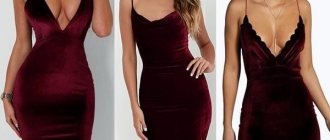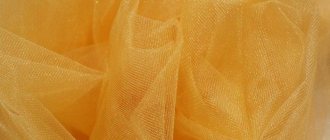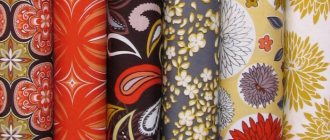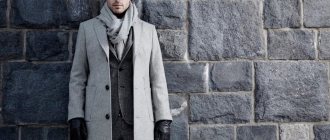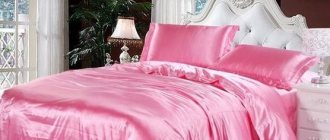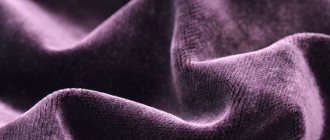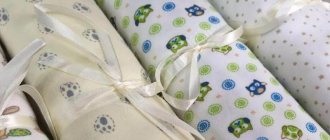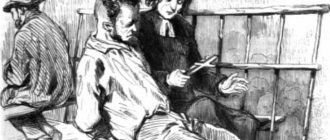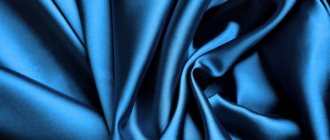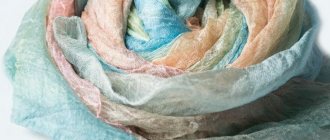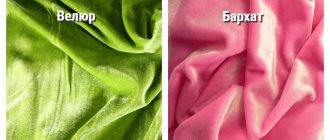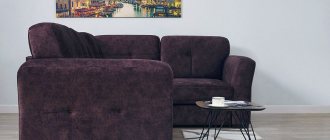This is interesting: Velor originally appeared in the East as a replacement for more expensive velvet. Even the French name velours means “velvet”. The Latin version of villosus is translated as “shaggy,” fluffy.”
Let's talk about production technologies
To make soft, velvety fabric, warp weaving is used. This technology comes in two types:
- Single panel. A special rod is inserted under the threads of the pile being formed. This is how loops are made. After fixing them, the rod is removed. The resulting pile is called looped. If you cut the loops, you get a cut pile.
- Double-sheet. Warp and weft threads create 2 independent fabrics.
- Between them the pile base is located in a zigzag pattern. This layer is cut using knives. The result is a fabric woven from 5 threads.
Fabrics with looped pile are elastic and stretch well. They are mainly used to make clothing. The scope of application of materials with cut pile is more extensive. It is found in home and automotive decor.
What are these materials used for?
Thus, all types of fabric with long and short pile are characterized by the following characteristics: wrinkle-resistance, soft pleasant texture, durability, non-wear, strength, elasticity, do not lose shape.
Used for sewing clothes, upholstery, etc. Nap fabrics require special care and careful use.
You might be interested in Description and types of lace: beautiful varieties of lace making
Modern times are full of different types of materials with pile; they are easy to sew, practical and do not require special care. Any item made of fabric looks beautiful and expensive.
Variety of composition
Initially, velor was made from silk. The fibers were also silk. During the production process, metal threads with a touch of gold and silver were added, which made it possible to create luxurious canvases that emphasized the high status of the owner. Products made from this fabric were available only to members of the aristocracy. Gradually, other raw materials began to be used. The material became publicly available, but did not lose its respectability and chic appearance. Today on the textile market you can find velor with a wide variety of compositions.
Cotton
The cotton base explains the hygiene of the fabric. It allows air to pass through well, absorbs moisture, preventing sweat from accumulating on the body, and eliminates the greenhouse effect. Cotton velor is heterogeneous in its structure. This group has its own varieties.
Velor knitwear
Excellent stretch, retains heat. There are 2 types:
- With interlacing fibers and threads.
- With the connection of loops of various shapes.
Knitwear includes plush and corduroy. Ideal for sewing children's clothes and tracksuits.
Velor terry
This variety can be found in any apartment. Often used as bath accessories: large towels, bathrobes, sheets.
Please note: Artificial threads (up to 25%) can be added to the composition of cotton velor. They increase the wear resistance of natural fibers.
Woolen
The basis is made of cloth yarn. It is not combed out; the result is a low, but thick, fluffy pile. Can be pure wool or mixed. Ideal raw material for demi-season outerwear and warm hats. An example would be felt. This group also includes several varieties.
Drape velor
It is distinguished by the highest quality class among all wool representatives. Merino sheep wool is used to make it. Weaving is done using the satin method. The fabric is thin and has great tensile strength. Luxury material that is very expensive.
Velor yarn
This is not canvas, but reinforced cotton threads with pile. The villi are attached in a special way. When the threads are twisted in factories, fibers are blown onto the threads using an air flow. They are permanently fixed at right angles. The material is intended for the manufacture of children's toys and various types of handicrafts. It is better to knit from yarn with knitting needles, as the hook will cause inconvenience.
Important: Velor yarn (its other name is chenille) does not hold its shape, patterns (elastic bands, braids) are not visible on it, but sweaters and jackets made from it keep you warm no worse than pure wool products. This is due to its high heat-conducting properties.
Synthetic
It is based on artificial threads: lycra, polyester, elastane. They can appear in different combinations and ratios. Velor synthetics have become widespread due to their high performance properties. It lasts a long time, does not tear, and is easy to clean. Such fabrics are not suitable for clothing, but they are indispensable for covers and car upholstery.
Microliner
It belongs to synthetic velor, but stands out in a separate category. The best artificial material. Its main properties are external aesthetics, abrasion resistance, moisture permeability, and pleasant tactility.
Leather
The raw material is leather that has flaws on the front side. Such defects do not affect the quality characteristics. It is polished and treated with chrome compounds. Products made from velor leather look stylish and enjoy a long service life.
Attention: Leather varieties are often confused with suede and nubuck, but they have different properties. A lower quality and cheaper analogue is split velor, from which workwear and mittens are made.
Fur
They are also made from animal skin. This is the inner layer - melon. Of all the layers of the skin, it is the least valuable. However, special processing, grinding, which gives the pile uniformity, and coloring increase its aesthetic qualities. A typical example is the outer surface of sheepskin coats.
This many-sided velor: main types
The soft, fleecy material is available in various variations. There are many groups and species. Numerous classifications are based on different criteria.
Classification by weave
In the production of velor fabrics, different weaving methods are used, so they differ significantly in appearance.
| Weave | Description |
| Knitted | A distinctive feature is that the base is not woven, but knitted. This explains the good elasticity, which allows you to create beautiful, soft draperies. |
| Satin | The long overlap of the threads allows you to get a sliding, shiny surface. The base predominates. There is one weft thread for every 4 warp threads. |
| Moiré | Characterized by heterogeneous pile. It has different lengths and directions. The result is a special pattern that is clearly visible when the lighting changes. |
| Jacquard | When weaving, different types of threads are used. Silk or lurex can be added to cotton ones. The result is a canvas with repeating, original rapports. This material is relevant for decorative purposes. It can often be found as furniture upholstery. |
Classification by texture
The fabric is also variable in appearance. The pile on it is located differently. Highlight:
- Smooth velor. Has a uniform front side. The villi are located vertically (up from the base).
- Shaped. The pile is uneven; alternation of fleecy and smooth areas is noticeable on the surface.
- Embossed. The figuratively arranged fibers represent an intricate pattern.
- Crash. The pile is dense, giving the canvas a visual bruised effect.
- Corrugated (maybe pleated). Characterized by clearly visible small folds.
Please note: Crash texture can be achieved by using natural and man-made fibers with a high polyester content (which makes up the majority). Corrugation is obtained from mixed synthetic fibers - viscose, polyamide, polyester in equal parts. Such fabrics necessarily contain a small percentage of elastane.
Classification by purpose
The use of velor is largely explained by its composition and properties. It is divided into several types:
- Dress. The name is quite arbitrary, since not only dresses are made from such fabric, but also suits, dressing gowns, and children's clothes. A distinctive feature is the natural composition. It is this that ensures comfortable use. Such products are warm and cozy.
- Interior. The fabric has also found its place among various home textile accessories. Velor curtains look expensive and elegant. The deep tones of the canvas are complemented by a stylish shine. These curtains are thick, drape well, forming soft folds.
- Furniture. Made from durable threads. It is wear-resistant and crease-resistant. Suitable for furniture with complex shapes, as the elastic fabric stretches well. Sometimes they are treated with special compounds, and the result is a vandal-proof fabric that perfectly protects against attacks by pets. Most often it is a mixed fabric. Although there are wool or silk upholstery.
- Automotive. It is used for reupholstering car interiors and for sewing seat covers. Must undergo additional processing. As a result, the material receives dirt- and moisture-proof properties.
Please note: The cost of velor varies widely. The cheapest varieties, made of 100% polyester, are produced in Turkey, Vietnam, and China. Italian canvases are considered elite. They contain a minimum of artificial additives and are manufactured using innovative technologies using modern equipment. Prices may vary by 5-6 times.
History of fabric
The technology of weaving velor fabric appeared in the East. The ancestor of velor was velvet, made from natural silk threads. A complex weaving method made it possible to create an exquisite fabric with a soft, velvety pile on the surface. In Europe, the production technology was simplified: the density of the weave of the warp threads was reduced, they stopped cutting the pile, and began simply combing it. Thus velor was born.
The name of the material has roots in Latin, translated as “hairy, shaggy,” reflecting the peculiarities of the appearance of the canvas.
Initially, velor was woven from natural silk. The canvas was decorated with thin braid and interspersed with gold and silver threads, and was used to sew clothes for the rich and decorate royal palaces. Replacing silk with cotton and wool threads made it possible to reduce the cost of fabric and launch its mass production.
A few words about colors
The color palette is varied. Dark colors look stylish. Lightness and romance, despite the solidity of the material, emanate from pastel shades. There are bright, catchy colors.
The canvases differ in the method of dyeing. There are:
- Plain painted. They look graceful and elegant. They are characterized by an interesting play of light. Either ready-made material or threads are dyed.
- Printed. Otherwise they are called printed (with a pattern). A printing machine uses stencils and cliches to apply a pattern to the surface of the fabric.
Please note: Velor holds dyes well, so it retains the brightness and richness of colors for many years. It does not fade, does not fade.
Properties
Fleecy fabric has become widespread due to its impeccable properties. Among them:
- Breathability. Even synthetic varieties provide good ventilation due to special weaving.
- Hygroscopicity. The material absorbs moisture well, while, like cotton, it remains dry for a long time.
- Thermal insulation. The space between the fibers plays the role of an air cushion, which does not allow cold air to pass through and retains heat well. You will never freeze in such clothes.
- Resistance to deformation. Varieties with a woven base do not stretch at all, but those with a knitted base quickly restore their original shape.
- Inert to ultraviolet light. The sun's rays will not harm matter. This is especially true for curtain fabrics. They may undergo additional processing to enhance this feature.
In addition, the material is wrinkle resistant. If a slight bruise occurs, it usually smooths out on its own, without additional effort.
Alcantara
Judging by the photo, this fabric can be confused with suede; sometimes it is called artificial leather, but it is an independent upholstery material. Thanks to the fleecy surface, the characteristics of the fabric resemble those of velvet, and the exclusive appearance and thermal conductivity make Alcantara more attractive than genuine leather.
Silky fabric breathes, is not afraid of dirt, does not make the body sweat in hot weather, heats up quickly in cold weather and is indistinguishable from expensive suede.
Bonus!
Now, if in the next scanword you come across the question, what is the name of fleecy fabric, 4 letters, you will probably guess that it is drape, and from 7 you can easily form the word “fumazea”.
The whole set of advantages
Velor attracts consumers with many advantages:
- Aesthetic appearance. It is not for nothing that previously only representatives of the noble class could wear clothes made from it. The material looks great. Additional attractiveness is provided by the play of halftones and muted shine.
- Good tactile sensations. The fabric is pleasant to the touch. I want to touch her all the time.
- Hypoallergenic. The fabric varieties from which products are made for going out or for home use do not contain synthetics, or they are present in small quantities. As a result, such material does not irritate or chafe the skin.
- Long service life. Natural velor cannot be called durable, but compared to other pile fabrics it is more wear-resistant. Things made from it can last up to 5 years even with intensive use. Especially with proper care.
- Practicality. The fabric is easy to clean, after washing it does not shrink, does not stretch, and retains its original appearance.
For reference: Thanks to its positive characteristics, the material has found its place in the production of children's clothing. Velor is safe even for newborns. Velvety and softness do not irritate children's skin, and breathability and moisture absorption prevent diaper rash and all kinds of skin diseases in babies. For example, prickly heat.
Customer Reviews
Buyers note that velor clothes are warm, comfortable, and cozy. Women love velor tracksuits, and young mothers buy warm velor suits for their babies.
The interior with velor elements gives the house a feeling of luxury. Furniture with velor upholstery looks elegant and respectable.
Pet owners warn that velor products attract fur and will require frequent cleaning.
Velor shoes are beautiful and elegant. Experienced owners warn that it gets wet and is only suitable for dry, clear weather.
Velor fabrics are varied, have their own characteristics, but have similar properties: they are warm, soft, resistant to wrinkles and wear. The practicality and noble appearance of velor allow it to remain popular in the world of fabrics and constantly gain new fans.
Briefly about the disadvantages
Despite a long track record, some properties of the fabric cause dissatisfaction among customers. The disadvantages include:
- The special structure of the material helps attract dust, hair and threads stick to the surface.
- Sometimes the villi can form creases, which are especially noticeable against a dark background under bright lighting. This does not affect the quality of the products in any way, but they do lose aesthetics. Things look sloppy and untidy.
- Fleecy materials do not tolerate ironing well. Softness and lightness disappear. Their appearance may not change for the better.
To avoid these shortcomings, you must treat products made from this fabric with care. Learn all the nuances of proper care. Sometimes velor is treated with special compounds to protect it from dust. This is true for automotive and furniture varieties.
Scope of application
Today, fabric is in demand in various areas of life. This is explained by its operational characteristics and availability. The material can be purchased at any fabric store.
| Scope of application | Examples |
| Manufacture of wearing apparel | For this purpose, cotton or wool velor is used. They sew from it:
|
| Shoes | Some types are used to make shoe uppers. Microliner is great for making insoles. It absorbs moisture well, and your feet feel comfortable in such shoes. This eliminates the occurrence of fungus. |
| Leather goods | You can find stylish bags and clutches made of leather varieties. Light shine combined with original fittings and decorative finishing make them real works of art. |
| Interior | Beautiful curtains for the living room, bedspreads and capes are made from velor. Decorative thought pillows look impressive and become a bright accent in the design. |
| Automotive industry | Velor seat covers look sophisticated and last a very long time. In addition, this lining prevents slipping. Some interior parts can also be decorated with this fabric. |
| Furniture manufacturing | Upholstering sofas and armchairs with this material will add luxury to upholstered furniture. The upholstery fabric is suitable for traditional and custom products. |
| Kids toys | Soft dogs and cats made of velor are absolutely safe. They are environmentally friendly and cannot harm the child in any way. And their velvety nature makes them favorites of little ones, because with such a faithful friend it is so comfortable to fall asleep and joyfully wake up. |
| Needlework | Knitted yarn - chenille - is suitable for this purpose. She is loose and fluffy. It is used for embroidery. In addition, craftswomen make beautiful knitted crafts from it. |
For reference: Every year velor finds new uses. Not so long ago they began to use it to decorate caissons (recesses and niches).
Recommendations for use
Excessive abundance of velvet both in the interior and in clothing is a sign of bad taste. Everything is good in moderation.
In clothes:
- Velvet goes well with jeans, wool knits, lace and synthetics. You can try to combine the material when creating an image with fur, silk, and leather. But with cotton and linen the combination will be unsuccessful.
- Jewelry, shoes and accessories should be chosen of high quality, not flashy, and elegant in design.
- The color of velvet is combined with products of muted tones, without bright shine.
In the interior:
- Velvet is not recommended for use in the design of small rooms: heavy material will visually make the room even smaller.
- Due to the accumulation of dust, velvet is not suitable for decorating a nursery, and due to its ability to absorb odors, it has no place in the kitchen.
- Interior velvet requires proper lighting: the light should fall against the direction of the pile; with light directed along the pile, the products fade and look unpresentable.
Proper care is the key to longevity
Luxurious fabric loves extra attention. The more carefully you treat her, the better she will look.
Clothes care
Includes 2 main procedures:
- Wash. Choose only delicate mode and a temperature no higher than +30 degrees. The material does not like to be twisted. If you use a machine spin, set the minimum speed.
- Drying. It is recommended to dry the product in natural conditions, but in a shaded place. The sun's rays negatively affect the condition of the wet fabric. There is no need to iron the velor. If small creases are noticeable, they can be straightened out using a steamer.
It is better to store velor clothes in covers. This will keep it from getting dusty.
Shoe care
If boots or shoes become wet or dirty, you need to wait until they are completely dry and carefully clean them with a rubber or high-stiffness hair brush. Movements should be smooth. The sole must be washed with soapy water. But you should make sure that water does not get on the surface of the shoes. Otherwise, there will be unsightly stains on it.
